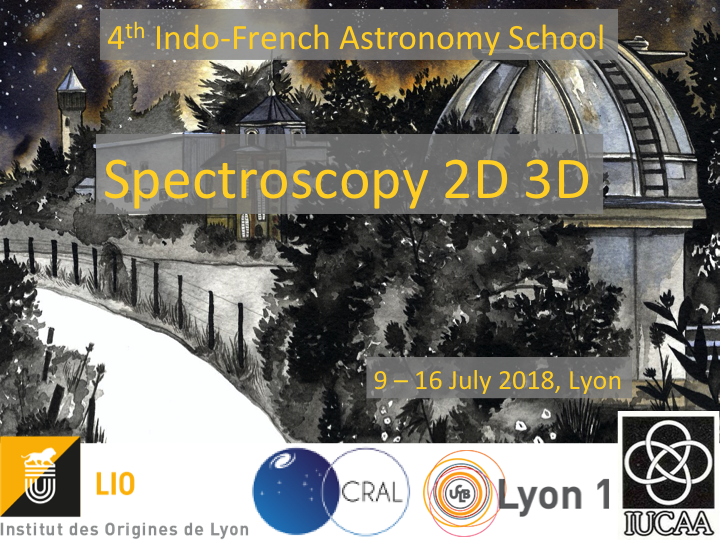School description > Research projects
The students will be separated in groups of four to five, and assigned to a research project under the supervision of an expert tutor. A total of 50 hours will be available to work on the projects.
The projects will be carried-on using the students own laptops (and access to remote servers when necessary), that shall ideally be running a Linux-like environment. Prescriptions concerning the software packages to be pre-installed will be communicated before the school.
The list of projects is below:
- Automated Spectral Classification of Two Spectral Libraries
Tutors: Ranjan Gupta (IUCAA, Pune) & Harinder P Singh (University of Delhi, New Delhi)
Description: The Project will involve Artificial Neural Network (ANN) based classification tools for two dimensional classification (Spectral Type and Luminosity) of stellar spectral libraries. The 1D spectra (ascii files) will be provided to the project group.
Software requirements: The participants shall keep Python/Matlab based open source ANN classification tools ready for performing the project on their laptops (preferably on LINUX or MAC; use the Matlab license of your home institute or university).
- Source detection and spectra deblending in crowded field.
Tutor: Ferréol Soulez (CRAL, Lyon)
Description: The goal of this project is to implement ‘inverse problems’ based methods to detect sources in crowded fields. It will use prior knowledge extracted from stellar spectral libraries.
Software requirements: It will be implemented in Matlab (use your home institute, or university license) using the GlobalBioIm library and the SPAMS library. The project participant should test the installation of these libraries on their laptop ahead of the beginning of the project.
- Determination of stellar atmospheric parameters of globular cluster stars from MUSE observations
Tutor: Philippe Prugniel (CRAL, Lyon) and Yue Wu (NAOC, Beijing, China)
Description: We will use the spectra of the globular cluster NGC 6397 stars extracted from MUSE cubes as described in Husser et al. (2016), in order to derive their atmospheric parameters and study the properties of the cluster.
Software requirements: IDL (use your home institute, or university license; IDL version 7 is sufficient) or GDL (the open source alternative), and ULySS.
- Analysis of CRISM data
Tutors: Cathy Quantin-Nataf (LGL-TPE) and Philippe Prugniel (CRAL, Lyon)
Description: We will use a spectral library (RELAB library) to perform spectral unmixing of martian CRISM data cube. CRISM is an imaging spectrometer with a scannable field of view that can cover wavelengths from 0.362 to 3.92 microns at 6.55 nanometers/channel. We will focus on the infrared channel from 1 to 3.92 microns of the targeted mode at a spatial resolution of 18m/pixel to retrieve the mineral diversity of the Martian surface.
Software requirements: IDL (use your home institute, or university license; or GDL, the open source alternative) or Pyhton, and ULySS.
- Source spectra detection and extraction from a MUSE cube, and emission line analysis and diagnostics
Tutors: David Carton (CRAL, Lyon) and Johan Richard (CRAL, Lyon)
Description: With MUSE data enabling us resolve scales below <500 pc we will study a sample of nearby (z~0.02) star forming galaxies. We will explore techniques that allow us to extract the emission line properties of star forming regions/clumps within these galaxies, with the ultimate goal of constructing maps of the star-formation rate, dust and metallicity.
Software requirements: (1) Python with packages: numpy, scipy, matplotlib, astropy, lmfit, mpdaf, and (optionally) pyqz
(2) ds9 (or other FITS image/cube visualization software);
(3) SExtractor (optional)
- Identifying emission-line objects and understanding the detection limits
Tutor: Mohammad Akhlaghi (CRAL, Lyon)
Description: The aim of this project is to identify emission-line only objects, detected in the deep MUSE HUDF field, see Bacon et al. (2017). Similar to that paper, the objects that don't have a Hubble Space Telescope (HST) broad-band imagining counterpart will be found (but with newer and much improved versions of the software). Special emphasis will be put on the completeness and purity of the detection process to understand the limits of any later analysis done on them. The project will also be done in a reproducible manner. See the published reproduction pipeline of the analysis in Bacon et al. (2017).
Software requirement: GNU Astronomy Utilities (version 0.6 or above, latest release), see installation instructions. To have a productive week in Lyon, please also do this tutorial prior to arrival (it uses the same HST dataset as this project). If there is any problem wih the installation or in the tutorial, please contact [bug-gnuastro@gnu.org].
|


